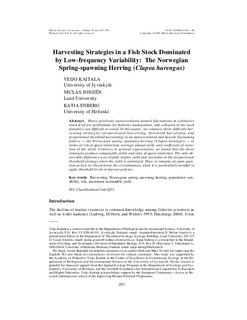| dc.contributor.author | Kaitala, Veijo | |
| dc.contributor.author | Jonzén, Niclas | |
| dc.contributor.author | Enberg, Katja | |
| dc.date.accessioned | 2010-10-29T11:57:03Z | |
| dc.date.available | 2010-10-29T11:57:03Z | |
| dc.date.issued | 2003 | |
| dc.identifier.issn | 0738-1360 | |
| dc.identifier.uri | http://hdl.handle.net/11250/108290 | |
| dc.description.abstract | Heavy positively autocorrelated natural fluctuations in a fisheries stock level are problematic for fisheries management, and collapses in the stock dynamics are difficult to avoid. In this paper, we compare three different harvesting strategies (proportional harvesting, threshold harvesting, and proportional threshold harvesting) in an autocorrelated and heavily fluctuating fishery — the Norwegian spring-spawning herring (Clupea harengus) — in terms of risk of quasi-extinction, average annual yield, and coefficient of variation of the yield. Contrary to general expectations, we found that the three strategies produce comparable yields and risks of quasi-extinction. The only observable difference was slightly higher yield and variation in the proportional threshold strategy when the yield is optimized. Thus, it remains an open question as how to characterize the circumstances when it is particularly needful to apply threshold levels in harvest policies. | en_US |
| dc.language.iso | eng | en_US |
| dc.publisher | Marine Resources Foundation | en_US |
| dc.subject | population dynamics | en_US |
| dc.subject | populasjonsdynamikk | en_US |
| dc.subject | catch strategy | en_US |
| dc.subject | fangststrategi | en_US |
| dc.title | Harvesting Strategies in a Fish Stock Dominated by Low-frequency Variability: The Norwegian Spring-spawning Herring (Clupea harengus) | en_US |
| dc.type | Journal article | en_US |
| dc.type | Peer reviewed | en_US |
| dc.subject.nsi | VDP::Agriculture and fishery disciplines: 900::Fisheries science: 920::Resource biology: 921 | en_US |
| dc.source.pagenumber | 263-274 | en_US |
| dc.source.volume | 18 | |
| dc.source.journal | Marine Resource Economics | |
| dc.source.issue | 3 | |
